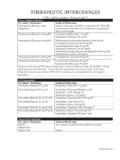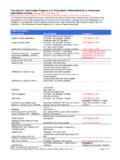Transcription of New Zealand Datasheet 1 PRODUCT NAME Dr Reddy’s …
1 New Zealand Datasheet 1 PRODUCT name . Dr Reddy's Omeprazole 2 QUALITATIVE AND QUANTITATIVE COMPOSITION. Omeprazole 20 mg capsules 3 PHARMACEUTICAL FORM. Omeprazole capsules 20 mg : hard gelatine size 2 capsules with a light grey opaque body printed with "R158" in black ink, and a purple opaque cap printed with "Omeprazole 20 mg ". in black ink. Each capsule contains omeprazole 20 mg as enteric coated pellets. 4 CLINICAL PARTICULARS. Therapeutic indications Dr Reddy's Omeprazole capsules are for the short-term relief of gastric reflux-like symptoms in sufferers aged 18 years and over.
2 Dose and method of administration Dr Reddy's Omeprazole capsules are recommended to be given in the morning and swallowed whole with half a glass of water. The contents of the capsule should not be chewed or crushed. For patients with swallowing difficulties the capsule can be opened and the contents swallowed directly with half a glass of liquid or after mixing the contents in a slightly acidic fluid fruit juice, yoghurt or in non carbonated water. The dispersion should be taken immediately or within 30 minutes.
3 Alternatively patients can suck the capsule and swallow the pellets with liquid. The pellets must not be chewed or crushed. Reflux oesophagitis The recommended dosage is one Dr Reddy's Omeprazole capsule 20 mg once daily. Symptom resolution is rapid and in most patients healing occurs within 4 weeks. The maximum daily dose should not exceed 20 milligrams. Impaired Renal Function Dose adjustment is not needed in patients with impaired renal function. Impaired Hepatic Function As bioavailability and plasma half-life of omeprazole are increased in patients with impaired hepatic function a daily dose of 10 - 20 mg may be sufficient.
4 Elderly Dose adjustment is not needed in the elderly. Contraindications Known hypersensitivity to omeprazole. Special warnings and precautions for use Dr Reddy's Omeprazole 20 mg capsules are for short-term use only, except on medical advice. Do not use the medicine for any purpose other than that specified on the pack, except on medical advice. Do not use in those that are experiencing weight loss, persistent regurgitation of food or vomiting, difficulty swallowing or symptoms of gastro-intestinal bleeding, except on medical advice.
5 Consult a doctor if symptoms persist, recur or worsen or if new symptoms occur. Consult a doctor or pharmacist before use if you are pregnant or are taking any other medicines. Decreased gastric acidity due to any means including proton pump inhibitors, increases gastric counts of bacteria normally present in the gastrointestinal tract. Treatment with acid- reducing medicines may lead to slightly increased risk of gastrointestinal infections such as Salmonella and Campylobacter and, in hospitalised patients, possibly also Clostridium difficile.
6 Subacute cutaneous lupus erythematosus (SCLE). Proton pump inhibitors are associated with very infrequent cases of SCLE. If lesions occur, especially in sun-exposed areas of the skin, and if accompanied by arthralgia, the patient should seek medical help promptly and the healthcare professional should consider stopping pantoprazole. SCLE after previous treatment with a proton pump inhibitor may increase the risk of SCLE with other proton pump inhibitors. Interaction with other medicines and other forms of interaction No interaction with food or concomitantly administered antacids has been found.
7 Nelfinavir, atazanavir Omeprazole has been reported to interact with some antiretroviral medicines. The clinical importance and the mechanisms behind these interactions are not always known. Increased gastric pH during omeprazole treatment may change the absorption of the antiretroviral medicine. Other possible interaction mechanisms are via CYP 2C19. For some antiretroviral medicines, such as atazanavir and nelfinavir, decreased serum levels have been reported when given together with omeprazole. Concomitant administration with omeprazole and medicines such as atazanavir and nelfinavir is therefore not recommended.
8 Citalopram / Escitalopram Co-administration of omeprazole ( 20 mg ) with citalopram ( 20 mg single dose) doubles the AUC of the S-isomer of citalopram, but the R-isomer of citalopram is not affected. A. reduction in the dose of citalopram may be necessary based on clinical judgement. For patients taking omeprazole, the citalopram dose should not exceed the maximum dose of 20. mg/day. Co-administration of omeprazole (30 mg) with escitalopram ( 20 mg single dose) increased the plasma levels (approximately 50%) and terminal half-life (31%) of escitalopram.
9 A. reduction in the dose of escitalopram may be necessary based on clinical judgement. Digoxin Concomitant treatment with omeprazole ( 20 mg daily) and digoxin in healthy subjects increased the bioavailability of digoxin by 10% (up to 30% in two out of ten subjects). Clopidogrel Results from studies in healthy subjects have shown a pharmacokinetic/pharmacodynamic interaction between clopidogrel (300 mg loading dose/75 mg daily maintenance dose) and omeprazole (80 mg daily, four times the recommended dose) resulting in decreased exposure to the active metabolite of clopidogrel by an average of 46%, and resulting in decreased maximum inhibition of (ADP induced) platelet aggregation by an average of 16%.
10 It is, however, uncertain to what extent this interaction is clinically important. One prospective, randomised (but incomplete) study (in over 3760 patients comparing placebo with omeprazole 20 mg in patients treated with clopidogrel and ASA) and non-randomised, post-hoc analyses of data from large, prospective, randomised clinical outcome studies (in over 47000 patients) did not show any evidence of an increased risk for adverse cardiovascular outcome when clopidogrel and PPIs, including omeprazole, were given concomitantly.
















